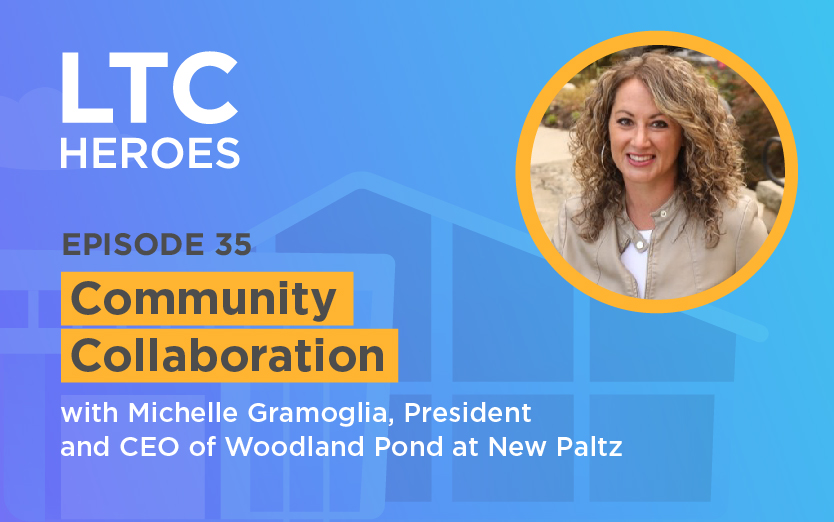In this episode of the LTC Heroes podcast, Michelle Gramoglia, President and CEO of Woodland Pond at New Paltz joins us to discuss how LTC organizations can effectively collaborate with their wider community.
Community Collaboration
Michelle explains that when your organization has a strong presence within a community, it’s important to develop symbiotic relationships with other organizations, businesses, and community members. By forming collaborations with entities like banks, clinics, schools, and other businesses, you can have a greater impact in your community and benefit your residents while doing so.
She gives us some examples of her organization’s current collaborations and highlights how to find success with these collaborations. She notes that being transparent and gaining buy-in from all stakeholders is a key priority when forming these relationships. She also mentions the importance of gaining clarity on the responsibilities within a collaboration in order to find the best possible way to work together.
Lifelong Learning Center
Michelle also discusses Woodland Pond’s lifelong learning center, which is a collaboration with the New Paltz State University of New York. She says it’s a great way to encourage residents to stay engaged while also providing the opportunity for other community members to enjoy learning something new.
Learn more and sign up to be notified about future episodes at LTCHeroes.com
Rapid Fire Q/A
Do you have any uncommon hobbies?
I spend a lot of time in my organic garden and that is where I get all of my soil therapy. It grows every year. Some years it is thriving, some years it’s failing. But that’s my hobby which I don’t think is normally something for somebody that’s, you know, middle-aged.
Is there anything from that hobby that could be translated or that has taught you about other situations or anything in LTC?
The concept is that sometimes it’s thriving, and sometimes it’s failing. When I get ready to get into my garden in February and March, I always have a great sense of optimism, even though this year, for example, my garden is essentially a failure. We’ve had so much rain in the northeast and my garden just can’t handle it all.
Next year, I know I will go into it as if this year never even happened. You know, every day in long-term care can be like that. And especially in a setting like ours, a continuing care retirement community, that has such a variety of levels of care. Because one day can be just the worst that you could have remembered in a long time. You have to dust off and start over again tomorrow. And equally, it could literally be the best day you’ve had in a long time. So 100%, the two things are parallel to me.
What’s the last book you’ve read that’s unrelated to LTC?
Gone With the Wind, and this was my sixth or seventh time reading it. I read it many times when I was a teenager and in my early 20s. I hadn’t read it in a long time so I picked it up and I read it again.
What’s one thing you would change about LTC?
I would change the funding that’s made available for the industry at both the federal and state level. Our seniors are continuing to age, but even now we are facing growing challenges with providing care cost-effectively.
I think that it’s an undervalued service in general because it is there. You can definitely see a distinction between the organizations that are able to invest their assets into excellent care provision. We are fortunate that we are able to do so in our community, probably more so than others just because of the way the models work in New York State for our type of community.
But I look at some of the county’s state-funded facilities and all I can think is that they don’t have enough to do the kind of care that they want to do.
What’s the biggest change you’ve seen in LTC?
Ten years ago, if you were an administrator in a long-term care facility, or you know, in my role as a CEO at a continuing care retirement community, you did not need to be concerned that you would ever have a shortage of a pipeline of staff. People were always wanting to get into providing care and working in this setting. And that has changed.
It’s challenging to maintain stable staffing. You’re being forced to make decisions about potentially letting someone go that might not be a great fit, even despite investing in education and training.
What do you expect to be the biggest change in LTC?
To some extent, we’re already seeing that the people who are moving into our communities, in every level of care, are a little bit older and a little bit higher needs incrementally every year. So there’s an acuity that’s getting worse. There’s aging that’s getting worse. There’s a higher level of care that’s needed. So I anticipate that you will see entrepreneurial organizations and forward thinkers trying to figure out a new type of long-term care residential setting that balances what is now becoming a very acute setting for places like Woodland Pond, especially in our skilled nursing unit. There will be more of a focus on the growth of, let’s say, an assisted living type environment, or an independent living type environment, with built in-home health care.
Resources
- mgramoglia@wpatnp.org
- https://woodlandpondnp.org/
- https://www.linkedin.com/in/michelle-gramoglia-790ba177/
Sponsored by Experience.Care
This episode is brought to you by Experience.Care, The only long-term care EHR backed by guarantees.
Your profitability is our priority and your compliance our cause. Since 1969.
Get your profitability consultation today at Experience.Care/guarantee. Our website is .Care for a reason. We care about your care. Visit us at Experience.Care.

